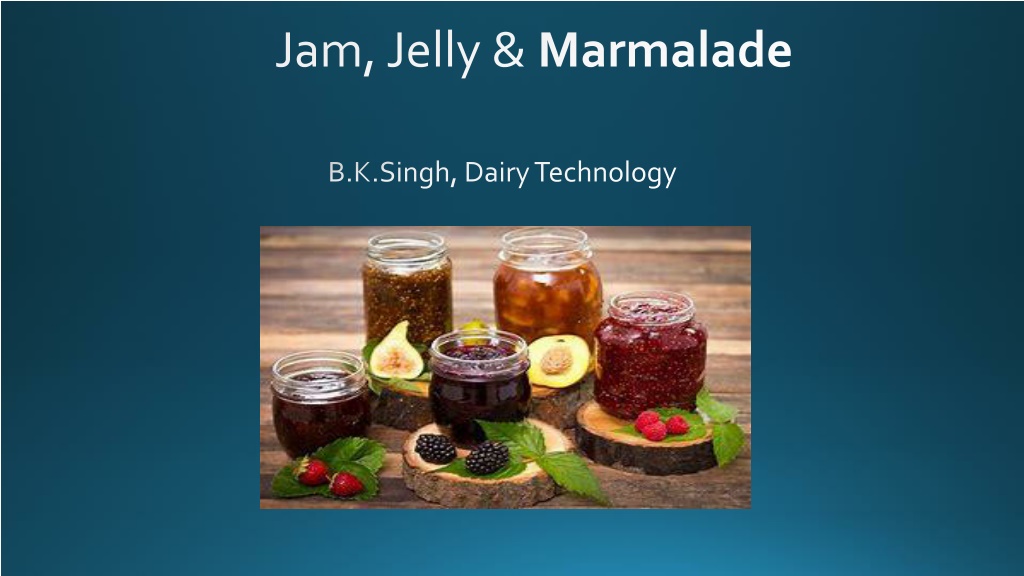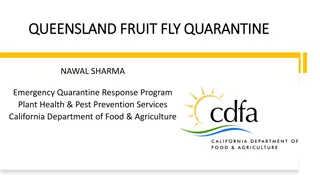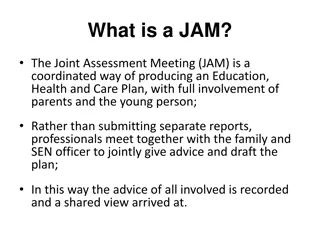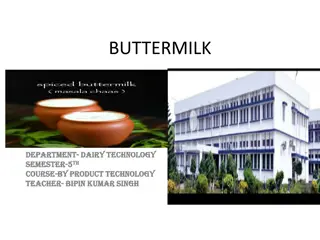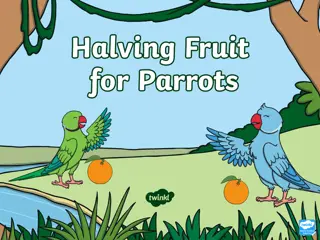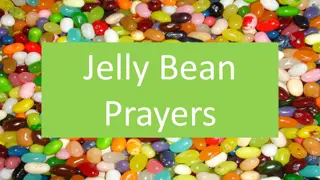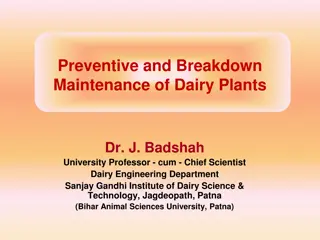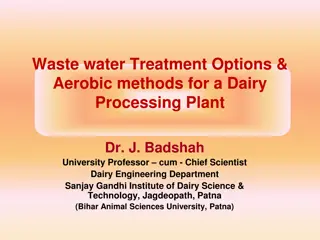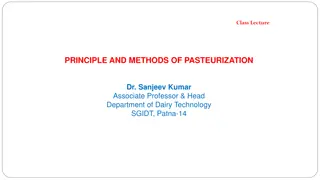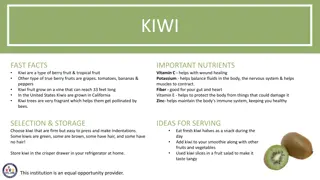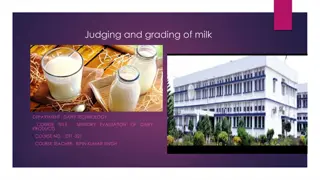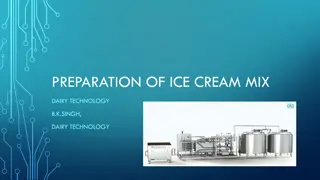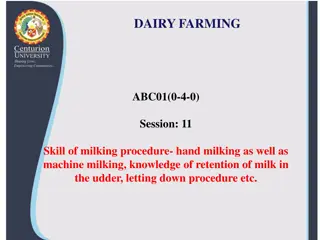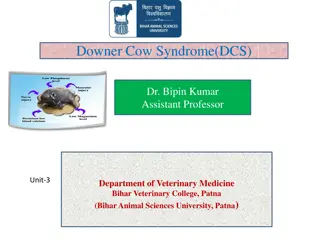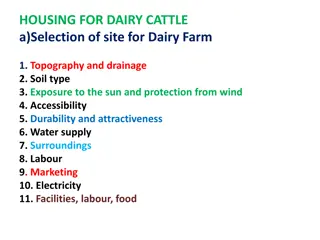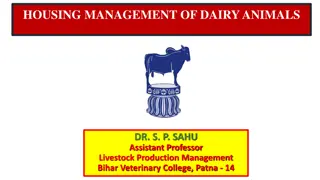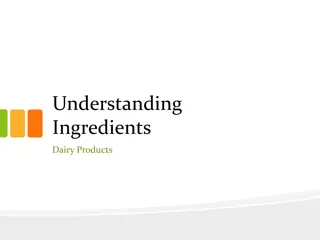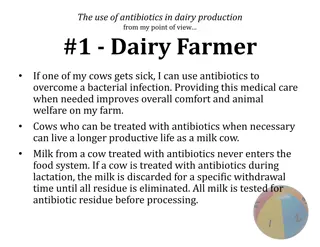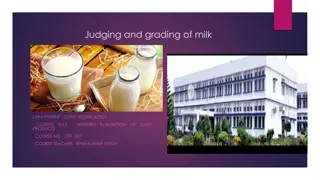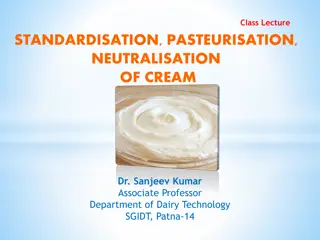Understanding Fruit Jam, Jelly, and Marmalade in Dairy Technology
Fruit jam, jelly, and marmalade are popular dairy products prepared from fresh or preserved fruits with nutritive sweeteners. These products have distinct characteristics and health benefits, such as being fat-free, cholesterol-free, and rich in pectin. Fruit jam specifically offers nutritional value with essential vitamins and minerals, promoting overall health.
Download Presentation

Please find below an Image/Link to download the presentation.
The content on the website is provided AS IS for your information and personal use only. It may not be sold, licensed, or shared on other websites without obtaining consent from the author. Download presentation by click this link. If you encounter any issues during the download, it is possible that the publisher has removed the file from their server.
E N D
Presentation Transcript
Jam, Jelly & Marmalade B.K.Singh, Dairy Technology
Fruit Jam As per FSSAI, Jam means the product prepared from sound, ripe, fresh, dehydrated, frozen or previously packed fruits including fruit juices, fruit pulp, fruit juice concentrate or dry fruit by boiling its pieces or pulp or puree with nutritive sweeteners namely sugar, dextrose, invert sugar or liquid glucose to a suitable consistency. It may also contain fruit pieces and any other ingredients suitable to the products. It may be prepared from any of the suitable fruits, singly or in combination. It shall have the flavour of the original fruit(s) and shall be free from burnt or objectionable flavours and crystallization.
Fruit Cheese As per FSSAI, Fruit cheese means the product prepared from pulp/puree of sound, ripe fruit (s), whether fresh, frozen or previously preserved or dry fruits, by cooking with salt, nutritive sweeteners to attain a thick consistency so that it sets on cooling. The fruit cheese shall be neither too soft nor too hard to chew. It may be prepared from any of the suitable fruits, singly or in combination. It shall have the flavour of the original fruit(s) and shall be free from burnt of objectionable flavours and crystallization.
Salient characteristics of Jam The amount of pectin in the gel is quite small (< 1.0% of the weight of jam); sugar content is very high (60- 70%). Of the remainder, the bulk is water with a small amount of fibrous matter and seeds. For a chunky texture, some pieces of fruit are added about 5 minutes before the cooking is finished. If a stiffer or sweeter jam is desired, more thickener or pectin, honeyor sugar may beadded.
Health Benefits of Fruit Jam It does not have fat and cholesterol which helps to gain a healthy weight. The pectin helps to lower the chances of cancer and promotes the health of skin, hair, bones and finger nails. It also lowers the chances of getting stroke, heart attack and cardiovascular ailments. It also lowers the developments of cancers in stomach, mouth and colon rectum. It reduces the chances of spina bifida, neural tube defects and anencephaly in pregnant women.
Nutritional Value One tablespoon of jam contains 6.09 g of moisture, 569 calories, 0.07 g of protein, 0.01 g of total lipid fat, 0.05 g of ash, 13.77 g of carbohydrate, 0.2 g of dietary fiber and 9.7 g of total sugars. It also provides 0.02 mg of copper, 1.8 mg of vitamin C, 0.1 mg of iron and 0.015 mg of vitamin B2.
Storage of Jam The surface of jam is susceptible to mold growth; yeast cannot grow or thrive. There is risk of mold development and fermentation, with alteration in the taste. Permitted preservatives may be used at levels sufficient to inhibit the growth of yeast and molds. Jam should be stored in a fairly cool place or else some moisture evaporates resulting in surface graining and shrinkage of jam. It should be stored in a placehaving RH of ~80%.
Judging the end-point Determining the boiling point with thermometer Hydrometers Refractometer Sheeting or Ladle test Weighing
Fruit Jelly As per FSSAI, Fruit Jelly means the product prepared by boiling fruit juice or fruit(s) of sound quality, with or without water, straining the juice, adding nutritive sweeteners, and concentrating to such a consistency that gelatinization takes place on cooling. The product shall not be syrupy, sticky or gummy and shall be clear, sparkling andtransparent. expressing and
Nutritional Value of Royal Jelly Royal jelly contains a rich variety of nutrients including minerals like calcium, copper, iron, and potassium, as well vitamins, biotin, inositol, folate, nucleic acids, gamma globulin, and 17 different amino acids, including the 8 essential amino acids that the human body cannot produce, and must, therefore, get from their diet. phosphorous, as a silicon, of sulfur, B-family wealth
Health Benefits of Royal Jelly Regulates Blood Pressure Balances Cholesterol Levels Treats Infertility Issues Anticancer Potential Can Reduce the Effects of Chemotherapy Reduces Inflammation Prevents Premature Aging Weight Loss Boosts Metabolism
Defects in Jelly Crystals in Jelly Cloudy jelly Failure to gel Tough Jelly
Marmalade Marmalade is a fruit preserve made from the juice and peel of citrus fruits boiled with sugar and water. The best-known version is made from bitter orange, but it is also made from lemons, limes, grapefruits, mandarins, sweetoranges,bergamots,and othercitrus fruits,or a combination. As per FSSAI, Marmalade means a product prepared by boiling sound fruits with peel, pulp and juice, with or without water, added nutritive sweeteners and concentrating to such a consistency that gelatinization takes place on cooling of the product. It shall not be syrupy, sticky or gummyand shallbeclear and transparent.
%Daily Value* Total Fat0 g 0% Saturated fat0 g 0% Polyunsaturated fat0 g Monounsaturated fat0 g Cholesterol0mg 0% Sodium179mg 7% Nutrition facts Marmalade, orange Amount Per 1 cup (320 g) Calories787 *Percent Daily Values are based on a 2,000 calorie diet. Your daily values may be higher or lower depending on your calorie needs. Potassium118 mg 3% Total Carbohydrate212 g 71% Dietary fiber2.2g 9% Sugar192 g Protein1 g 2% Vitamin A 0% Vitamin C 26% Calcium 12% Iron 3% Vitamin D 0% Vitamin B-6 5% Vitamin B-12 0% Magnesium 2%
Specific Requirements Total soluble solids (m/m) -Min. 65.0 % Fruit content except peel (m/m) - Min. 45.0 % Peel in suspension -Min. 5.0 %
Antique cutter, used to cut citrus fruit peel into thin slices marmalade Marmalade spread on bread
